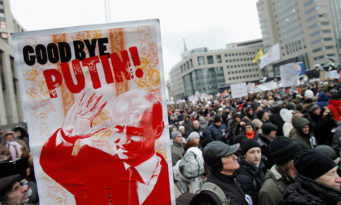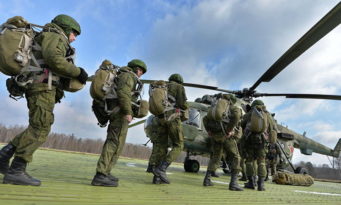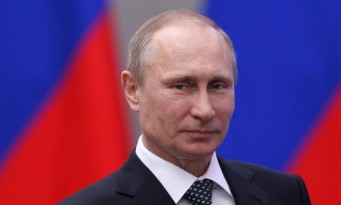ISIS: A Revolutionary Group, Fighting a Textbook Insurgency?

- By Octavian Manea
You should fight against ISIS the way governments fought against Marxist rebels: by designing a counter-revolutionary counterinsurgency.
In the second part of a three part series of interviews conducted at the Nafplio Olympia Summer Academy Professor Stathis N. Kalyvas discusses insurgency and counter-insurgency. "[...] effective counterinsurgency is so hard; because it requires the kind of commitment that produces state building-the provision of public goods and the creation of effective governance", he states. He explains what made robust insurgency the preferred technology of rebellion during the Cold War and talks about the nature of the Islamic State.
How does a counterinsurgent/insurgent obtain the support and collaboration of the people? Is it about legitimacy? Is it about control? Bernard Fall used to talk about establishing “competitive systems of control”. What does your research suggest?
My research suggests that like in many social activities it is always about a mix of consent and coercion. I find it that the behaviour in civil wars has a lot in common with taxation. There is an element in which people have to be induced to do certain things because they think it is acceptable. For example, the capacity of a group to effectively govern a territory and supply public goods and governance is important. But on the other hand, without any coercion, no one would pay anything. The other thing that I find very important is that sources of consent do not necessarily emerge out of abstract promises, political promises of some sort. There is a source that has been overlooked which is the fact that insurgents can take advantage of the negative externalities of the activities of counterinsurgents and vice-versa. For instance, counterinsurgents are very good at generating collaboration through consent of the local population by taking advantage of excessive and misguided behaviour of the insurgents. In Iraq a big reason why the surge worked was that many tribes in the Anbar provinces switched sides. Of course for that to happen it is not enough to point out that the insurgents are bad. You also you need to provide security so that the people who want to defect are protected from reprisals. If there is no security, defectors are going to be punished by the insurgents and that makes it very difficult for the others to follow their example.
Winning hearts and minds has become a mantra of the post 9/11 counterinsurgency doctrine. Can hearts and minds be ultimately won?
As the experience of counterinsurgency (but also insurgency) shows, they are often won. The key question, of course, is how. The answer, in my opinion, has to incorporate the fluid dynamic of war. There is a strong self-reinforcing dynamic in these processes: by winning, you show that you are stronger and by appearing stronger, you can win more easily. A lot hinges on perceptions, perceptions then shape reality and in turn this new reality alters future perceptions. Of course, the process can be reversed, which is why you need consistency and willingness to fight over the long term.
For many of the current or past conflicts there is the tendency to blame the so-called “ancient hatreds”. In early 1990s, the Clinton administration used to invoke the thesis of the ancient hatreds as an argument for justifying its non-intervention in the ethnic conflicts that were destroying the Balkans and former Yugoslavia. And in the Jeffrey Goldberg’s interview with Obama, the president talks about the power of tribalism as an argument to stay away from these spots. Do you see any validity in the ancient hatreds thesis?
It is true that ethnic identities (and in general what we call “ascriptive identities”) tend to be good predictors of behaviour. But it is not true that they are impossible to overcome. Very often, they have been overcome, but that does not mean that people change their identities. In a paper (“Ethnic Defection in Civil War”) I argue that in many wars, people fight against their ethnic group. That requires a political armed actor to appeal to people to defect from the political organisation that claims to represent their group and its best interests. People are not going to defect if there is nowhere to defect. Secondly, there has to be some sort of reason for people to do. Either they were victimised or they operate on sub-ethnic, clan logics.
Bernard Fall remains famous for saying that “when a country is being subverted, it is not outfought, it is being out-administered. Subversion is literally administration with a minus sign in front”. The implication of his point was that countering a robust insurgency meant first of all countering its ability to govern, to administer territories, perform and establish parallel state-like functions. Is this point still valid today in the current security environment where we see a myriad of entities that replicate a similar behaviour from narco-gangs to warlords?
I believe so. Fundamentally, I think civil wars are about state-building. Therefore, the ability to develop state capacity not just in military terms, but also in administrative terms is an essential feature of both insurgency and counterinsurgency. That’s why effective counterinsurgency is so hard; because it requires the kind of commitment that produces state building-the provision of public goods and the creation of effective governance, i.e. a very tall order. Over the past few years we’ve seen a growing literature about rebel governance. Criminal groups and warlords that can out-administer actual states, assume the burdens of government, provide justice and order in the territories they control. Roving bandits become stationary bandits, in the terminology used by Mancur Olson. Fighting against incipient state-builders requires that you state-build yourself.
Everyone is running away from expeditionary COIN. Both Obama and now Trump are bluntly challenging the notion of nation-building overseas. The alternative is highly kinetic CT and aerial bombardment. Do you see any chance to deal with movements and actors whose focus is on state-building only through kinetic means?
CT can prove useful as a way of containment in the short and medium term but if you want to address more fundamental issues (such as state building, by the way…) and make sure that the war is brought to the conclusion without necessitating a need for new intervention you have to invest. Today there is a reluctance on behalf of the international community to invest in state building. That is true for both the economic side, especially development, but also for the political and military side.
There is also a huge emphasis on the good governance part. Can a counterinsurgency campaign be effective without good governance?
The problem with good governance is that it is a very long-term project and it is good not be thinking of shortcuts because there are not that many. But there is also a concept of effective governance which may be less demanding than good governance and more achievable in the short and medium term. Perhaps the way to good governance is effective governance. But it might be a necessary way, it is clearly not a sufficient one.
What made robust insurgency the preferred technology of rebellion during the Cold War?
It was a package of things that are associated with the Cold War that made robust insurgency intertwined with this particular historical context. On the one hand you had the ability of the major superpowers like the Soviet Union to provide military assistance, massive material support, and all kinds of training for recipient insurgent movements all over the world. The second thing was the idea that you can actually set-up a political organisation based on a revolutionary ideology and beliefs. Thirdly it was the organisational dimension, the idea of a transnational network of activists, revolutionaries and radical entrepreneurs that were supported by Soviet Union that gave the ability to fight others’ people wars. All these elements should be understood in the context of the proliferation of a very specific military doctrine of revolutionary war which became known as the Maoist approach – where success was based on the incremental construction of a political organisation whose aim was to govern territory, provide effective administration and build an effective counter-state – that gave a lot of these movements not necessary a set recipe but a set of tools to implement some of those ideas. It was the combination of all these factors that were combined during the Cold War that explains the emergence and the relative success of the robust insurgency. It is also this combination of factors that transformed traditional guerrilla in a very powerful and effective technology of rebellion.
Don’t we have a similar sequence today, where we see the competition between external actors - like Russia and US - overlapping with the proxy wars between regional competitors?
Exactly. In Syria, the competition between Saudi Arabia, the Gulf States, and Turkey on the one hand and Russia and Iran on the other hand, with the US somewhere in between certainly creates a similarity with the so-called proxy wars in the Cold War. Essentially the outside actors contribute both to the escalation and to the longer duration of the conflict and make it appear intractable. The resolution of this conflict is likely to come from outside as well.
It seems that we have the same dynamic also in Ukraine. Russia exploited various societal cleavages, a weak state and hollow institutions to back its proxy actors in Eastern Ukraine. On the other side, EU and some NATO actors are providing support for Kiev. It is a competition between rival external actors.
That is correct. We see that in Ukraine, although to a far smaller extent compared to Syria. The difference is a power mismatch with a very strong Russia vis-à-vis the Ukrainian state. An important dimension is that Russia is a contiguous state to the Ukraine with very concrete interests there. Certainly the presence of a safe haven in the contiguous country is increasing the duration of the conflict.
How should we understand the nature of the Islamic State? Is it an insurgency, a terrorist group?
I see ISIS as a revolutionary group, presently fighting a textbook insurgency. I start with a very simple premise: revolutionary actors tend to believe in radical social change. And this comes with a number of implications. It is not so much about transforming the external boundaries of states although that can be part of the agenda. Revolutionary actors tend to motivate their cadres, they tend to have a long-term strategy and planning, and they also raise an existential threat for the governments they fight against, which may actually backfire. During the Cold War, revolutionary Marxist groups were both high quality rebels and more likely to be defeated by the governments they fought against.
What are the policy implications that derive from understanding ISIS as a revolutionary group? What do past cases of dealing with revolutionary groups tell us about the options to counter them?
You should fight against ISIS the way governments fought against Marxist rebels: by designing a counter-revolutionary counterinsurgency, namely one that addresses the many political and social dimensions that motivate the insurgency and by crafting a powerful alliance of external backers. Right now, this does not seem to be the priority of either the Iraqi state, let alone of the Syrian regime.
Has ISIS become a powerful external sponsor who has the ability to support clandestine networks far away from its homeland? The attacks in Paris and Brussels could be an example or the ISIS branch in Libya. It seems that ISIS is acquiring the same traits that made the robust insurgency successful during the Cold War: funding, transnational movement and organisational doctrine.
ISIS lacks a key feature of many Marxist rebels: a powerful external sponsor. Its resort to transnational terrorism is counterproductive: a sign of weakness already backfiring against it.
How useful do you find the FM 3-24?
These kinds of manuals tend to be very broad general. This particular one should be seen more in terms of dynamics internal to the US military (getting it to pay attention to a non-state, not conventionally organised for) than in terms of a specific recipe on how to defeat an insurgency.
What insights from the political science research should be incorporated into the elaboration of the COIN/stabilisation doctrine?
I will mention three key insights: international politics, state capacity, and political dynamics at the ground-level, including ethnic and clan politics.
Was the AQI insurgency both a Maoist people’s war and at the same time a sectarian/inter-communal war? What strategies should/could follow from this reading?
Yes, but so were many Marxist insurgencies, such as the PKK in Turkey. From the perspective of the counterinsurgent, decoupling the revolutionary dimension from the ethnic one is key. It worked during the “surge” and then it failed due to the Maliki government ethnic sectarianism, leading to the transformation of the AQI insurgency into the present ISIS one. Underneath both of them, we can clearly distinguish the Baathist infrastructure that channels communal Sunni grievances.
Stathis N. Kalyvas is Arnold Wolfers Professor of Political Science and Director of the Program on Order, Conflict, and Violence at Yale University. He is the author of The Logic of Violence in Civil War (Cambridge University Press, 2006) The Rise of Christian Democracy in Europe (Cornell University Press, 1996), and Modern Greece (Oxford University Press, 2015), as well as the co-editor of Order, Conflict & Violence (Cambridge University Press, 2008).

















